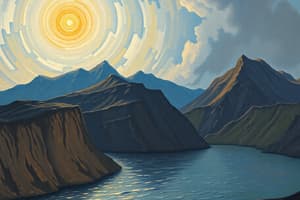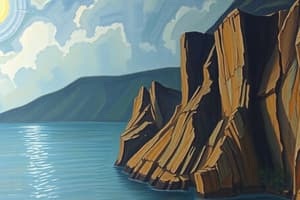Podcast
Questions and Answers
What is the main reason behind Uranus' blue-green color?
What is the main reason behind Uranus' blue-green color?
- Interaction with hydrogen and helium gases
- Reflection of sunlight by Uranus' cloud tops
- Presence of water and ammonia in its atmosphere
- Absorption of the red portion of light by methane gas (correct)
Where did Uranus likely form before moving to the outer solar system?
Where did Uranus likely form before moving to the outer solar system?
- Around Jupiter's orbit
- In the Kuiper Belt
- In the asteroid belt
- Close to the Sun (correct)
Why do metal spacecraft face challenges in Uranus' atmosphere?
Why do metal spacecraft face challenges in Uranus' atmosphere?
- Interference from Uranus' magnetic field
- Strong gravitational pull towards the surface
- Extreme pressures and temperatures would destroy them (correct)
- The lack of methane for fueling
What is the primary composition of Uranus' atmosphere?
What is the primary composition of Uranus' atmosphere?
Which spacecraft observed dynamic clouds on Uranus during its approach to equinox?
Which spacecraft observed dynamic clouds on Uranus during its approach to equinox?
What makes Uranus colder than Neptune in some places?
What makes Uranus colder than Neptune in some places?
What feature did Voyager 2 observe on Uranus during its 1986 flyby?
What feature did Voyager 2 observe on Uranus during its 1986 flyby?
What factor contributes to wind speeds reaching up to 560 mph on Uranus?
What factor contributes to wind speeds reaching up to 560 mph on Uranus?
'Uranus doesn't have a true surface' because:
'Uranus doesn't have a true surface' because:
'More recent observations reveal dynamic clouds on Uranus' primarily during which astronomical event?'
'More recent observations reveal dynamic clouds on Uranus' primarily during which astronomical event?'
Flashcards are hidden until you start studying
Study Notes
Earth's Lithosphere and Plate Tectonics
- The lithosphere comprises the crust (continental and oceanic) and the upper mantle, divided into tectonic plates.
- Plates move continuously; for instance, the North American plate advances westward over the Pacific Ocean basin at a rate comparable to fingernail growth.
- Earthquakes occur due to interactions between these plates, including grinding, colliding, and separating actions.
Earth's Global Ocean
- Covers nearly 70% of the Earth’s surface with an average depth of about 2.5 miles (4 kilometers).
- Contains 97% of the Earth's water and almost all volcanoes lie beneath these oceans.
- Mauna Kea, a volcano in Hawaii, is taller from base to summit than Mount Everest, with most of it submerged underwater.
- The longest mountain range extends underwater at the bottoms of the Arctic and Atlantic oceans, four times longer than the Andes, Rockies, and Himalayas combined.
Earth's Atmosphere
- Composed of 78% nitrogen, 21% oxygen, and 1% other gases (argon, carbon dioxide, neon).
- Influences Earth’s climate patterns and local weather, and protects against harmful solar radiation.
- Shields against meteoroids, which burn up in the atmosphere before reaching Earth’s surface, becoming visible as meteors.
Sun's Photosphere and Atmosphere
- The photosphere radiates sunlight, reaching Earth about eight minutes after emission, with a temperature of around 10,000°F (5,500°C).
- Above the photosphere are the chromosphere and corona, constituting the Sun’s thin atmosphere.
- The chromosphere features sunspots and solar flares, visible during total solar eclipses as a red rim, while the corona appears as a white crown with plasma streamers.
- Uniquely, the temperature of the Sun's atmosphere increases with altitude, reaching up to 3.5 million°F (2 million°C).
Potential for Life on Earth
- The Sun itself is inhospitable for life due to its extreme heat and energetic gases.
- Provides essential warmth and energy, enabling organisms, particularly plants, to form the foundation of Earth's food chains.
Celestial Bodies
- The Sun and other stars do not possess moons; instead, they have planets, moons, asteroids, and comets in their orbits.
Studying That Suits You
Use AI to generate personalized quizzes and flashcards to suit your learning preferences.




